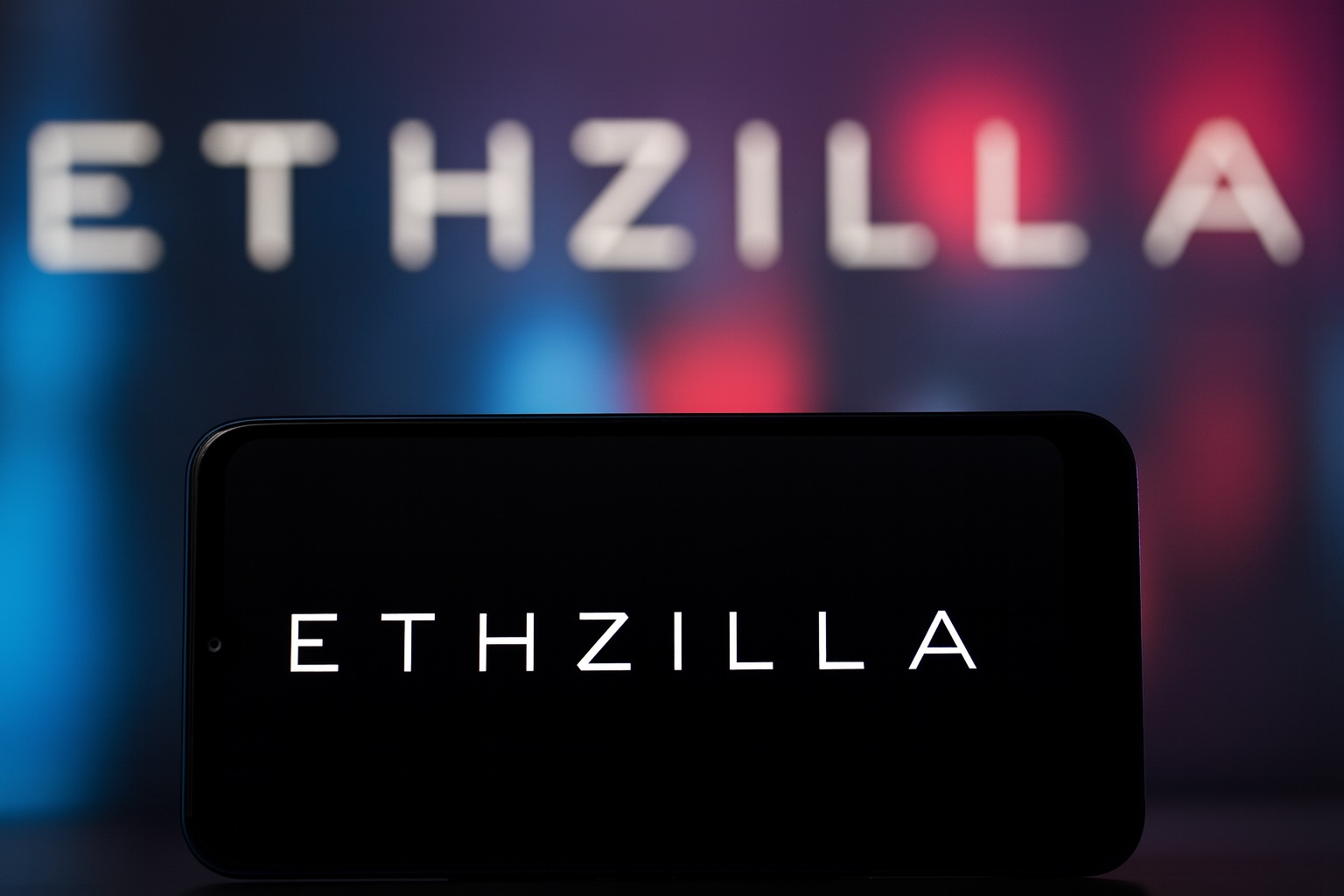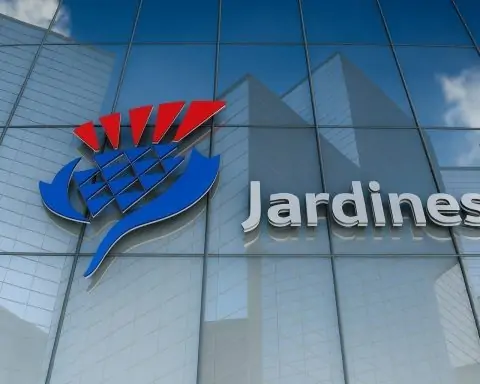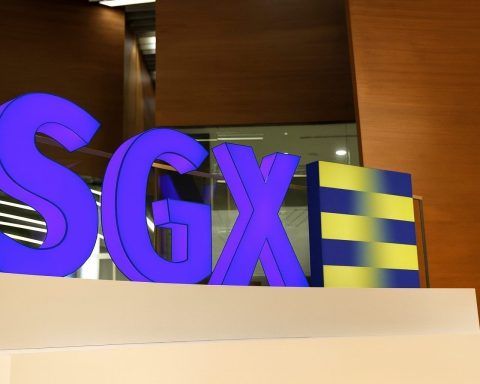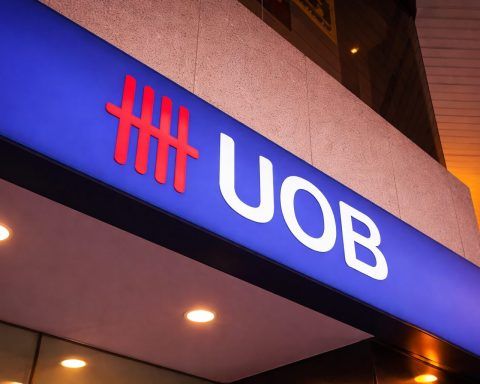What to Know Before Markets Open on October 20, 2025
- ETHZ Stock Volatility: ETHZilla (NASDAQ: ETHZ) shares trade around $1.68 (pre-split) as of Oct. 20, 2025, equivalent to ~$16.80 post-split, after a steep 15% slide last week [1]. Despite recent drops, the crypto-focused stock remains up over 90% year-to-date [2].
- Crypto Pivot & Thiel Backing: Formerly a biotech firm, ETHZilla rebranded in July to build an Ethereum treasury. Billionaire Peter Thiel’s 7.5% stake fueled a 207% one-day stock surge in August [3], as investors piled into its bold crypto bet.
- Reverse Split Effective: A 1-for-10 reverse stock split takes effect today to boost the share price above $10 [4]. Management says the move is designed to attract institutional investors constrained by low-priced stocks [5]. Shares dipped ~5% on the announcement [6] amid short-term jitters.
- Major Moves & News: ETHZilla holds about 102,000 ETH (over $400 million worth) in its treasury [7] alongside $215 million in cash/stablecoins [8]. In recent weeks it launched a $250 million share buyback [9], deployed $100 million into Ethereum staking via Ether.fi [10], invested $47 million with DeFi protocol Puffer [11], and secured a $350 million convertible financing to bolster its balance sheet [12].
- Analysts & Outlook: Experts say ETHZ’s fate hinges on Ethereum’s trajectory. “ETHZilla’s stock price may be highly correlated to the price of the digital assets that it holds,” the company cautions [13]. Forecasts are upbeat – analysts see Ethereum potentially rallying to ~$7,700 by 2026 [14], which would lift ETHZ’s asset value. Still, market watchers warn of extreme volatility ahead as ETHZilla pioneers a new crypto-stock model [15].
ETHZilla Stock on a Wild Ride After Crypto Pivot
Warsaw, Oct. 20, 2025 – ETHZilla Corporation’s stock has been on a roller-coaster ride in recent months, as the company’s high-stakes pivot into cryptocurrency testingly swings investor sentiment. Shares of ETHZ (NASDAQ) closed Friday at $1.68 before a 1-for-10 reverse split (roughly $16.80 in post-split terms) [16]. That price is down about 15% from a week ago (ETHZ closed at $1.98 on Oct. 13 vs. $1.67 by Oct. 16 [17]), reflecting a sell-off surrounding its latest corporate actions. Even so, ETHZilla’s stock is still up over 90% year-to-date [18] – and more than 100% in the past six months [19] – a testament to the crypto-fueled hype that sent shares soaring in late summer.
The dizzying ups and downs started when ETHZilla – until recently a little-known biotech called 180 Life Sciences – announced in July that it would transform into a cryptocurrency investment vehicle. The firm rebranded as “ETHZilla” and vowed to accumulate Ethereum and pursue decentralized finance (DeFi) ventures [20]. This radical strategy shift immediately caught the market’s attention. In August, billionaire Peter Thiel disclosed a 7.5% stake in ETHZilla, lending heavyweight credibility to the venture. The news triggered a frenzy: “Shares in the firm skyrocketed” as Thiel’s involvement came to light [21]. On the day ETHZilla’s crypto strategy was unveiled, the stock surged 207% in a single session [22], an eye-popping jump reflecting investors’ optimism about its Ethereum-based model.
That euphoria, however, was followed by whiplash. Within weeks of the peak, ETHZilla’s stock plunged sharply, wiping out a chunk of those gains [23]. To stem the slide and underscore confidence, the company’s board authorized a massive $250 million stock repurchase in late August. “An aggressive stock repurchase program at the current stock price underscores our commitment to maximizing value for shareholders,” Executive Chair McAndrew Rudisill said at the time [24]. The buyback news initially sent the stock up nearly 14% intraday, though ETHZ ultimately reversed to close down 3% that day amid profit-taking [25] – a microcosm of the stock’s extreme volatility.
Major Moves: Building an Ethereum Treasure Chest
Behind the drama is ETHZilla’s emergence as a unique publicly-traded Ethereum treasury and DeFi player. The Palm Beach, Fla.–based company has amassed approximately 102,000 ETH (Ether) tokens in recent months, making it one of the largest corporate holders of Ethereum globally [26]. At current prices, that hoard is worth over $400 million and places ETHZilla among the top six public Ethereum treasuries [27]. The company also holds around $215 million in cash and stablecoins to deploy [28]. In effect, ETHZilla has turned its balance sheet into an Ethereum vault, aiming to give stock investors exposure to the second-largest crypto asset.
But ETHZilla isn’t just passively HODLing crypto – it’s actively putting those assets to work in DeFi for yield. In early September, the firm announced plans to deploy $100 million of its ETH into ether.fi, a liquid staking protocol [29]. Liquid staking allows ETHZilla to earn staking rewards (interest for helping secure the Ethereum network) while maintaining flexibility via tradeable staked-ETH tokens. Just weeks later, ETHZilla said it will allocate an additional $47 million (about 10,600 ETH) into Puffer Finance [30] – another Ethereum-based protocol – to enhance treasury yields through “restaking.” Puffer’s technology effectively compounds staking returns, aiming for higher annual yields by re-deploying rewards [31]. “Beyond baseline staking rewards, Puffer takes advantage of compounding and selling strategies… to maximize returns,” explained Amir Forouzani, a Puffer contributor, about the partnership [32].
These moves illustrate ETHZilla’s goal of becoming not just a crypto holding company, but a profit-generating DeFi platform. By integrating with protocols like ether.fi and Puffer, ETHZilla seeks to earn outsized yields on its Ether. Typical Ethereum staking yields are around 3–5% annually, but restaking can boost potential APY into the high single or even double digits [33]. Management’s recent updates suggest ether accumulation has paused since August 31, as focus shifts to “optimizing existing holdings and returning value to shareholders” via yield and buybacks [34].
To fund its ambitious plans, ETHZilla has been bolstering its war chest. In September the company secured a $350 million convertible debenture investment from an institutional partner [35], providing fresh capital. Notably, ETHZilla has been creative in financing buybacks without selling its crypto: it tapped a major trading firm (Cumberland/DRW) for an $80 million loan collateralized by part of its Ether holdings [36]. This allowed the company to repurchase about 2.2 million shares (pre-split) at ~$2.50 each [37], reducing its float by 1.3%, without depleting its Ethereum stash. Such maneuvers mirror strategies used by crypto-heavy companies like MicroStrategy, which borrow against Bitcoin reserves to fund activities [38]. In ETHZilla’s case, management believed the stock was deeply undervalued – calculating a net asset value around $3.99 per share (pre-split) based on total assets of $656 million vs. the market price near $2.50 [39]. This “sum-of-the-parts” math helped justify the aggressive buyback program.
The company has also been beefing up its leadership team. Earlier this month ETHZilla appointed Jason New – Vice Chairman of Investment Banking at Lazard and a veteran of credit and private equity – to its Board of Directors. “Jason’s deep expertise across credit markets and digital assets makes him an outstanding addition to our Board,” Rudisill said in the appointment announcement [40]. The addition of a Wall Street heavyweight signals ETHZilla’s intent to navigate both traditional finance and crypto markets, aligning with its mission to “bridge traditional finance and decentralized finance” [41].
Reverse Stock Split Aims to Lure Big Investors
This Monday, October 20, marks another pivotal moment: ETHZilla’s 1-for-10 reverse stock split becomes effective, and the stock will begin trading on a split-adjusted basis today [42]. Every 10 pre-split shares of ETHZ have been consolidated into 1 share, multiplying the share price roughly tenfold. The immediate goal is to boost ETHZilla’s stock price well above the psychological $10 threshold – not for vanity, but to court institutional investors. “As part of ETHZilla’s effort to expand engagement with institutional investors, the reverse split is designed to provide these investors access to collateral and margin availability associated with stock prices greater than $10.00,” the company explained in a post on X (formerly Twitter) [43]. Many large mutual funds and institutions are barred from buying equities trading in low single-digits. By delivering a double-digit share price, ETHZilla hopes to “enable broader participation from sophisticated capital” and “position it for long-term growth,” the firm noted [44].
The reverse split, which was approved by shareholders in July [45], reduces ETHZilla’s outstanding share count from roughly 160 million to about 16 million shares [46]. Importantly, the split is not driven by Nasdaq listing requirements (ETHZ was in compliance) but rather by strategic positioning [47]. No change was made to the company’s ticker (it remains “ETHZ”) or its public warrants (trading as “ETHZW”) [48].
Initial market reaction to the split announcement was mixed. When ETHZilla revealed the plan last week, the stock fell over 5% by the next trading day [49]. Some investors interpret reverse splits as red flags for struggling companies. However, ETHZilla’s management emphasized the opposite in this case – that the move reflects strengthening fundamentals and outreach to bigger backers, not desperation. The company pointed out that the split will not alter any shareholder’s proportional ownership or the underlying value of the firm, and no fractional shares will be issued (cash will be paid in lieu of any fractions) [50]. By tightening the share structure, ETHZilla aims to “strengthen access to capital markets” and shake off any “penny stock” stigma [51] [52].
Market watchers say a higher share price could put ETHZilla on the radar of funds that couldn’t touch it before. “Many large mutual funds have minimum stock price thresholds… regardless of market cap,” the company noted [53]. Clearing that hurdle might open doors for new institutional ownership, especially given ETHZilla’s unique positioning in the crypto sector. “This decision reflects a strategic alignment with institutional standards,” ETHZilla posted, adding that it “supports [our] long-term capital markets strategy” [54]. In other words, the company wants to be taken seriously by Wall Street as a legitimate Ethereum proxy.
Of course, execution is key. Thus far, ETHZilla has delivered on assembling a formidable Ethereum trove and crafting a narrative as a bridge between TradFi and DeFi. It generates “recurring revenues” through DeFi yields and aims to tokenize real-world assets via Ethereum [55] – an effort to give its crypto holdings practical utility. These initiatives will likely be detailed further when ETHZilla reports earnings later this week (its Q3 2025 results are due on Oct. 23 [56]). Investors will be watching for clues on how much revenue the Ethereum deployments are producing, and any guidance on future ETH acquisitions or partnerships.
What Analysts and Experts Are Saying
ETHZilla’s bold experiment has drawn both enthusiasm and caution from financial experts. Supporters view the company as a trailblazer in bringing crypto to the capital markets. With Ethereum up ~45% this year [57] and hitting record highs near $5,000 in late August, ETHZilla’s timing appears fortuitous. “More investors view Ethereum as ‘Wall Street’s likely blockchain of choice’… With several corporations (from fund manager Bitmine to ETHZilla) accumulating Ether in treasury reserves, bullish sentiment around Ethereum’s network effect is rising,” reported TS2, a tech finance outlet [58]. In other words, ETHZilla is part of a wider institutional pivot toward Ethereum, as big money seeks exposure to the surging crypto beyond just Bitcoin. The involvement of figures like Peter Thiel underscores that trend. “Thiel’s 7.5% ETHZilla stake signals a broader shift to Ethereum as a yield-generating asset,” noted a report by AIvest, which highlighted how companies like ETHZilla are redefining corporate treasury management [59] [60].
On the flip side, skeptics argue that ETHZilla remains a highly speculative play. The company has scant operating history in its new domain and essentially functions as an Ethereum holding trust with a tech veneer. “ETHZilla’s stock price may be highly correlated to the price of the digital assets that it holds,” the company itself warned in an SEC filing [61]. This means the stock’s fate could swing with the volatile crypto market – a double-edged sword. If Ether soars, ETHZilla’s assets (and perhaps its stock) could appreciate significantly. But if crypto prices crash or DeFi yields disappoint, ETHZilla’s valuation and liquidity could deteriorate just as fast. “The risk that the company’s stock price may be highly correlated to the price of… assets it holds” was explicitly flagged to investors, alongside regulatory and operational risks [62].
Technical analysts note that ETHZilla’s stock chart has been challenging for traders. After peaking in mid-August (pre-split ~$17.46 [63]), the share price trended downward, falling over 84% from that high by early October [64]. “Some negative signals were issued… the long-term moving average is above the short-term, giving a more negative forecast,” observed one algorithmic analysis of ETHZilla [65]. The stock has dropped in 7 of the last 10 trading days and is down ~34% over the past two weeks [66]. Momentum gauges like the Relative Strength Index (RSI) recently hit oversold levels (below 20) [67], which can sometimes precede a relief bounce – but can also indicate a stock that “may drop long and hard while being oversold… increasing the general risk,” the analysis warned [68]. The bottom line: volatility is sky-high. ETHZilla’s daily trading range has frequently swung 8–10% or more [69]. “This stock is considered ‘very high risk’,” the technical report concluded [70], advising close monitoring by investors.
Financial commentators are divided on the long-term outlook. Some see tremendous upside if ETHZilla successfully executes its vision. “If ETHZilla can keep [its Ethereum investments] ‘sticky,’ it may prove that institutional restaking isn’t just possible – it’s better than vanilla ETFs,” wrote Macauley Peterson of Blockworks, suggesting ETHZ’s active yield strategy could potentially outperform a passive Ethereum ETF [71]. The idea is that ETHZilla offers something more than a crypto ETF: not only holding ETH but also generating additional yield, which could compound returns in a rising market. There is also the prospect of ETHZilla leveraging its platform to tokenize assets or provide DeFi services, which could create new revenue streams beyond just holding Ether.
Macro tailwinds could bolster the bull case. Wall Street’s interest in Ethereum is climbing, evidenced by major firms pursuing Ethereum ETF approvals and by public companies like Coinbase holding thousands of ETH on their balance sheets [72]. “Over 1.74 million ETH – valued at $6.5 billion – is now held by publicly traded firms… These entities are not merely accumulating ETH; they are deploying it on-chain to generate returns,” the AIvest report noted [73] [74]. This institutional adoption supports the notion that ETHZilla is riding a secular wave. Some analysts are even forecasting Ethereum’s price to climb to $7,700+ by 2026 amid this trend [75]. Should ETH truly rally that dramatically (roughly doubling from current levels), ETHZilla’s core assets would appreciate in tandem, potentially boosting its book value and stock price significantly.
That said, risks abound. Crypto markets can be unforgiving – sharp corrections in Ether’s price would directly hit ETHZilla’s asset values (and could force the firm to write down holdings under accounting rules if prices drop below cost basis [76]). There’s also execution risk: ETHZilla must convince investors it can safely earn high yields on its ETH without taking excessive risks or falling victim to smart-contract bugs, hacks, or unstable protocols – perennial concerns in DeFi. Any major glitch or loss could be a serious setback for a company whose credibility is tied to deftly navigating the crypto ecosystem.
Regulation is another wild card. Thus far, regulators have treated Ethereum and staking favorably – the U.S. SEC in 2025 reclassified Ether as a non-security utility token, providing clarity, and even indicated that certain yield-generating activities, when done passively, do not violate securities laws [77] [78]. This has been a tailwind for ETHZilla and peers. However, the regulatory landscape can change, and global authorities are still crafting rules for corporate crypto treasury operations.
Market Forecast: Cautious Optimism
Going forward, ETHZilla faces a pivotal test: can it deliver real value as a public company, beyond just the sum of its crypto parts? In the near term, all eyes are on the company’s next steps after the reverse split. Will new institutional investors actually come aboard now that shares trade in a more “acceptable” price range? The company’s ability to communicate a clear business model will be crucial. Investors will listen for updates on revenue generation (e.g. how much yield the Ether.fi and Puffer deployments are producing) and any signs of scalability – such as partnerships to tokenize assets or provide DeFi services to other firms.
Market sentiment on ETHZ remains closely linked to sentiment on Ethereum itself. If the current crypto uptrend continues, ETHZilla is positioned as a leveraged proxy on ETH. “Analysts project ETH to $7,709 by 2026 as institutional adoption drives a new bull market,” noted Rhys Northwood, a market analyst, highlighting the upside scenario [79]. Under that bullish scenario, ETHZilla’s holdings would swell in value, and its pioneering status could attract more investors seeking equity exposure to crypto’s growth. The stock could also benefit from scarcity value – there are only a handful of public companies focused on Ethereum, and even fewer actively using DeFi to enhance returns.
However, in a bearish scenario (for crypto broadly), ETHZilla could find itself in a tough spot. Unlike diversified tech firms, ETHZ’s fortunes are tied to one highly volatile asset class. A steep drop in ETH’s price would not only hit the company’s net assets but could also dampen the appeal of its story. The share buyback buffer provides some support – management can argue the company has confidence in its intrinsic value and has reduced share count, potentially aiding EPS in the long run. But ultimately, ETHZilla needs Ethereum to thrive to vindicate its strategy.
For now, many analysts are preaching cautious optimism. “We’re in uncharted territory – it’s essentially a crypto ETF plus an active DeFi hedge fund rolled into one stock,” said a strategist at a crypto investment firm (who preferred not to be named). “If it works, ETHZilla could blaze a trail. If not, it’ll serve as a cautionary tale.” In the short run, volatility is expected to persist. Automated trading models have flagged ETHZilla as a “sell” in the near term due to its downward momentum [80] [81], and even the company’s own risk disclosures underscore the uncertainties.
Bottom Line: ETHZilla has captured imaginations with its audacious Ethereum gambit, turning a former biotech minnow into a $270 million-market-cap crypto whale. The stock’s wild swings – from summer skyrocket to autumn shakeout – reflect the market’s struggle to price such a novel entity. As of today, with a leaner share structure and new capital in hand, ETHZilla is entering its next chapter. Investors on Google News and beyond will be watching closely to see if this Ethereum “zilla” can live up to its monster ambitions, or if the volatility will prove too monstrous for the faint of heart.
Sources: Financial releases and data from Yahoo Finance [82] [83] and Nasdaq [84]; company statements via Investopedia and PR Newswire [85] [86]; Decrypt and CoinCentral news reports [87] [88]; Blockworks industry analysis [89]; TS2.tech crypto market commentary [90]; AInvest research [91]; and other reputable financial media. All information is up to date as of Oct. 20, 2025.
References
1. www.nasdaq.com, 2. finance.yahoo.com, 3. www.ainvest.com, 4. finviz.com, 5. decrypt.co, 6. www.investing.com, 7. decrypt.co, 8. www.investopedia.com, 9. www.investopedia.com, 10. blockworks.co, 11. blockworks.co, 12. blockworks.co, 13. www.prnewswire.com, 14. www.ainvest.com, 15. stockinvest.us, 16. stockanalysis.com, 17. www.nasdaq.com, 18. finance.yahoo.com, 19. decrypt.co, 20. www.investopedia.com, 21. decrypt.co, 22. www.ainvest.com, 23. decrypt.co, 24. www.investopedia.com, 25. www.investopedia.com, 26. decrypt.co, 27. decrypt.co, 28. www.investopedia.com, 29. blockworks.co, 30. blockworks.co, 31. blockworks.co, 32. blockworks.co, 33. www.edgen.tech, 34. www.edgen.tech, 35. blockworks.co, 36. www.edgen.tech, 37. www.edgen.tech, 38. www.edgen.tech, 39. www.edgen.tech, 40. www.prnewswire.com, 41. decrypt.co, 42. finviz.com, 43. decrypt.co, 44. decrypt.co, 45. finviz.com, 46. finviz.com, 47. finviz.com, 48. finviz.com, 49. www.investing.com, 50. finviz.com, 51. coincentral.com, 52. coincentral.com, 53. finviz.com, 54. decrypt.co, 55. finviz.com, 56. stockanalysis.com, 57. ts2.tech, 58. ts2.tech, 59. www.ainvest.com, 60. www.ainvest.com, 61. www.prnewswire.com, 62. www.prnewswire.com, 63. www.barchart.com, 64. stockinvest.us, 65. stockinvest.us, 66. stockinvest.us, 67. stockinvest.us, 68. stockinvest.us, 69. stockinvest.us, 70. stockinvest.us, 71. blockworks.co, 72. www.ainvest.com, 73. www.ainvest.com, 74. www.ainvest.com, 75. www.ainvest.com, 76. www.prnewswire.com, 77. www.edgen.tech, 78. www.edgen.tech, 79. www.ainvest.com, 80. stockinvest.us, 81. stockinvest.us, 82. www.nasdaq.com, 83. finance.yahoo.com, 84. www.nasdaq.com, 85. www.investopedia.com, 86. finviz.com, 87. decrypt.co, 88. coincentral.com, 89. blockworks.co, 90. ts2.tech, 91. www.ainvest.com









